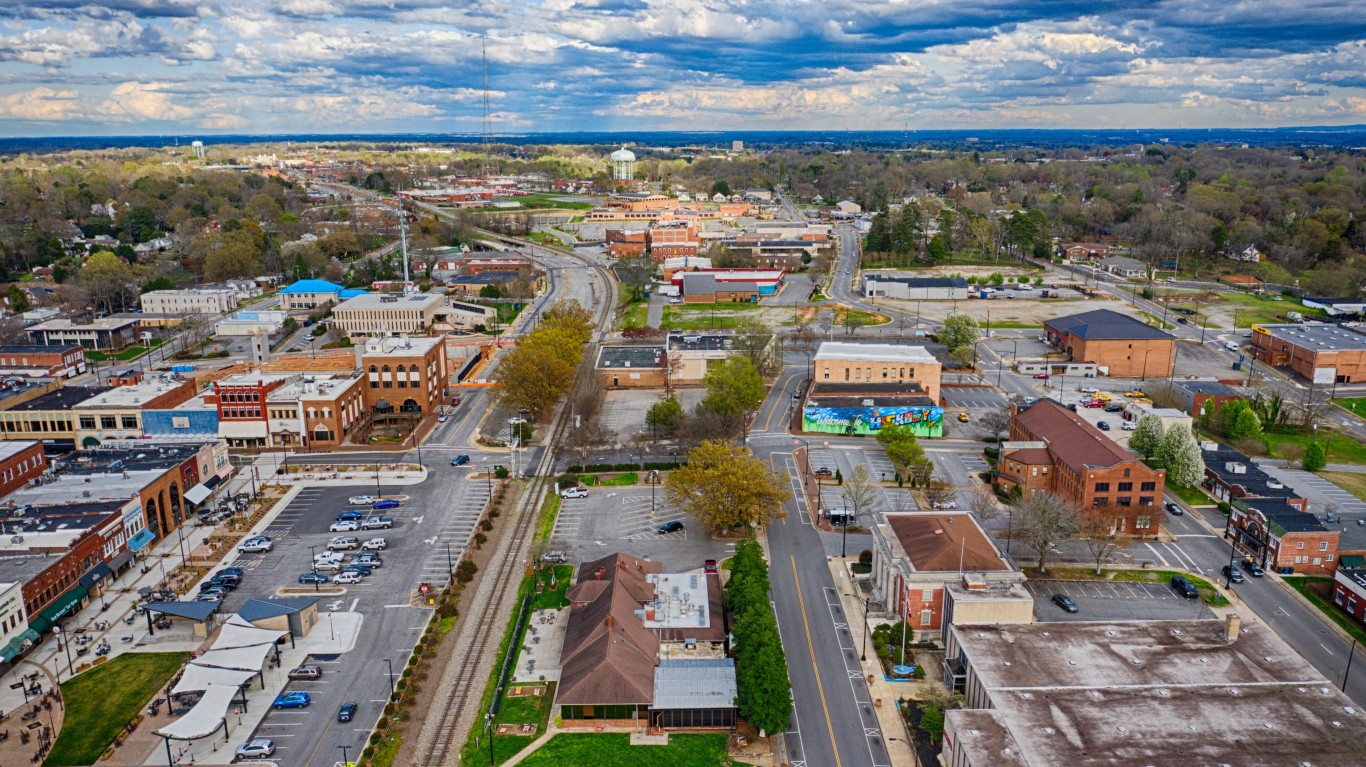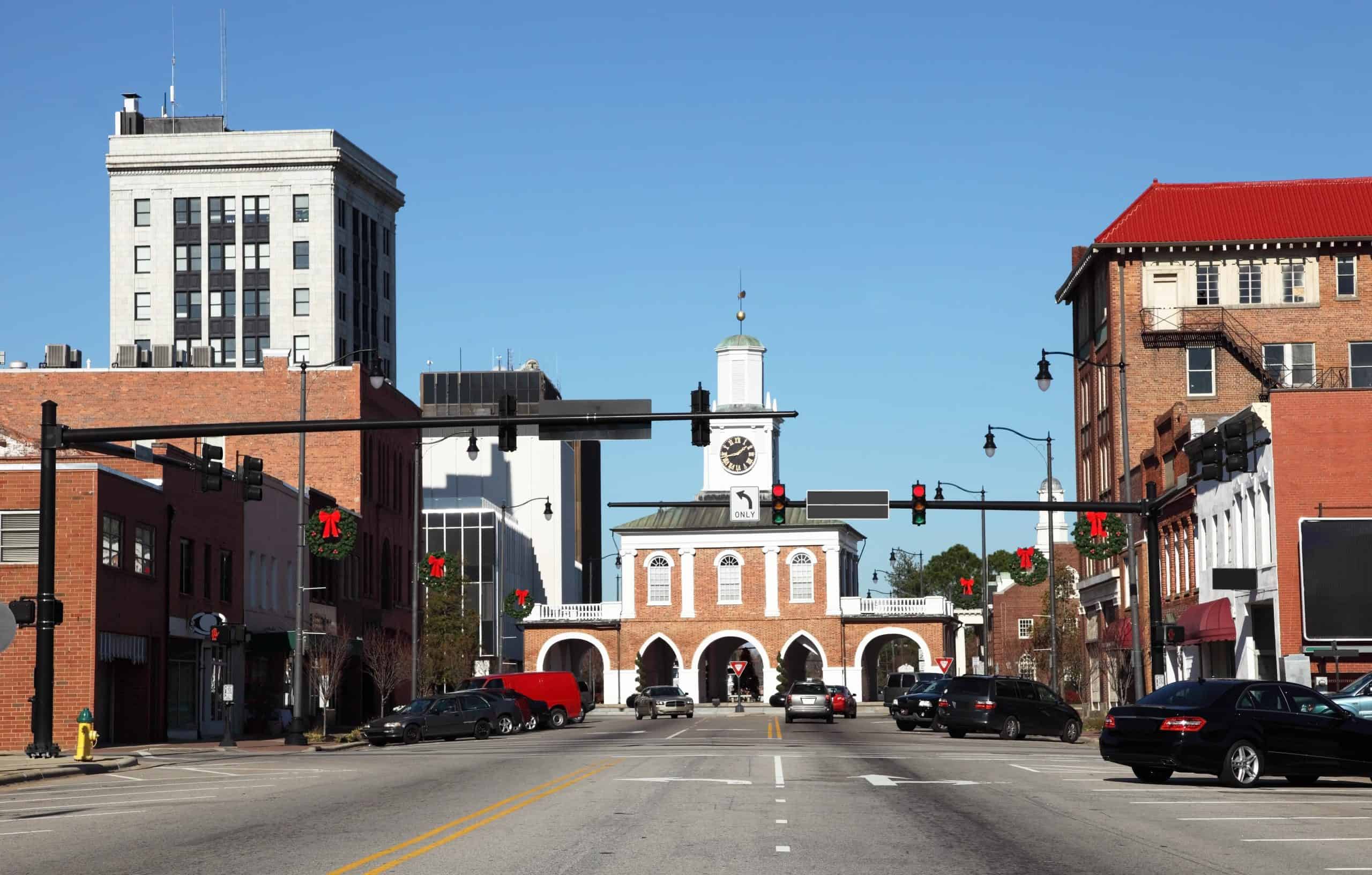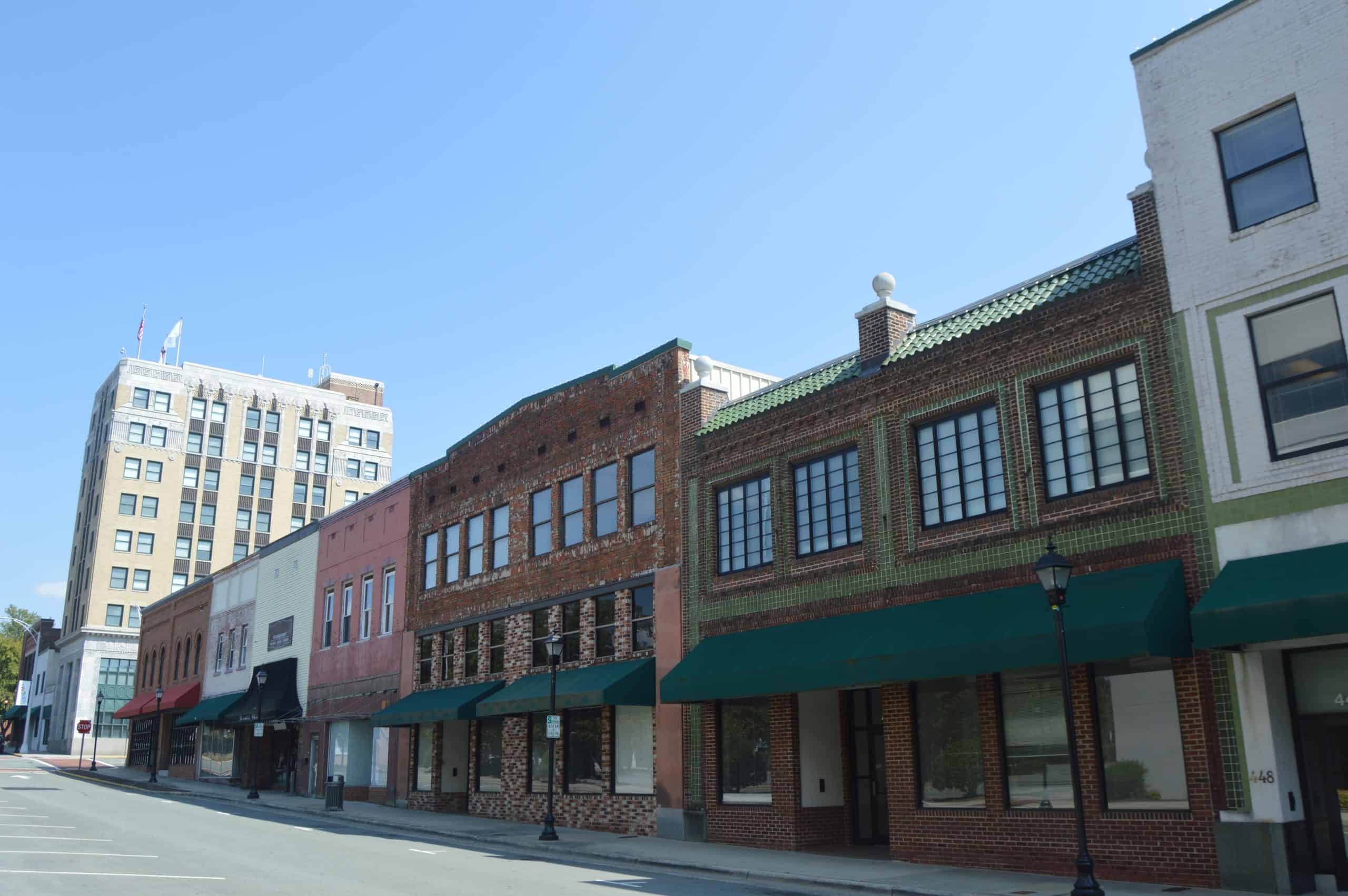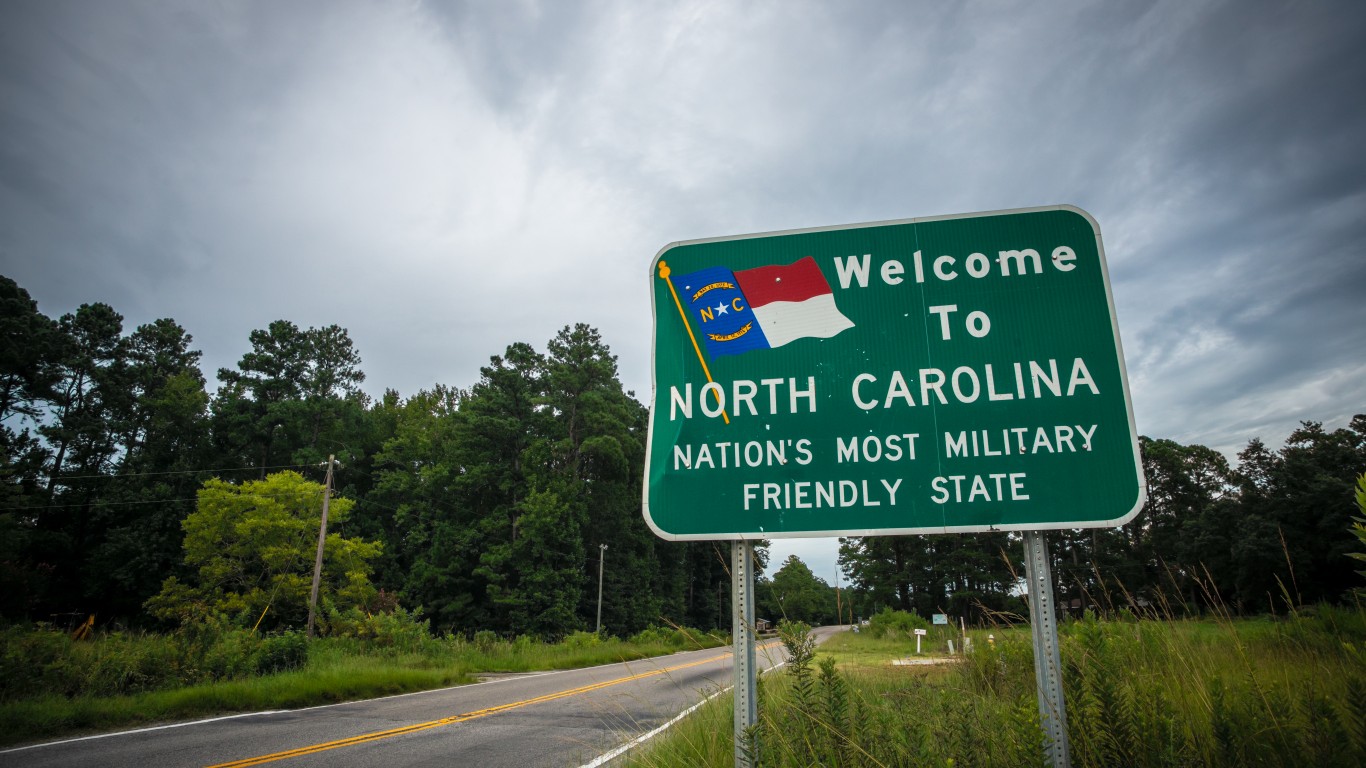
24/7 Wall St. Insights
- Nationwide, the cost of living tends to be higher in cities than in places outside of major metro areas
- Still, consumer prices can vary considerably from one city to another, and some North Carolina metro areas are more affordable for a broader range of incomes than others
- Also: 2 Dividend Legends To Hold Forever
The overall cost of living has climbed at a historic pace in recent years, and the impact on American families has been both financial and psychological. A recent survey conducted by the U.S. Census Bureau found that over 57% of Americans reported difficulty affording usual household expenses in the last week, and that more than 93% of adults in the U.S. have experienced stress related to higher prices in the last two months.
According to the Consumer Price Index, the rate of inflation began to rise in early 2021, and ultimately peaked in June 2022, when the price of goods and services were 9.1% higher than they were one year earlier. While inflation has been steadily falling in recent months, the CPI remains above the Federal Reserve’s 2% target rate.
While no one was spared from rising consumer prices, in relative terms, the overall cost of living varies considerably across the country. In North Carolina, for example, goods and services were about 5.8% less expensive, on average, than they were nationwide in 2022 — the latest year of available data. Despite a lower cost of living, 56.7% of North Carolina households had difficulty paying for household expenses in the last week, and 93.6% of adults in the state reported stress resulting from rising prices. (Here is a look at the most expensive states to live in.)
Generally, Americans living in major cities are saddled with a higher cost of living than those in smaller, rural communities. According to the Bureau of Economic Analysis, goods and services are about 11.4% more expensive within U.S. metro areas than they are outside of metro areas.
In keeping with this pattern, goods and services are only about 4.7% less expensive than average across all 15 North Carolina metro areas, and 11.5% less expensive in non-metro areas. Still, the overall cost of living can vary meaningfully between one North Carolina city and another. In the state’s least expensive metro area, consumer prices are about 12.2% lower than they are nationwide on average. Meanwhile, in the state’s most expensive city, prices are only about 1.6% lower than average. (Here is a look at the most affordable town in every state.)
Consumer prices tend to rise when demand for goods and services outpaces supply. Because cost of living is closely tied to consumer spending, it is no coincidence that more affluent areas are typically more expensive places to live than lower income communities. Not surprisingly, the median household income in some of the most expensive cities on this list is higher than the comparable statewide median income of $67,481.
This is the cost of living in every North Carolina metro area, ranked.
Why It Matters

Inflation, as measured by the Consumer Price Index, hit a multi-decade high in 2022, and as of July 2024, the CPI remains well above the Federal Reserve’s 2% target. Even though prices tend to be far higher in cities than in rural communities, the vast majority of Americans — 80% according to the U.S. Census Bureau — live in an urban area. Still, consumer prices can vary considerably from one city to another, and some North Carolina metro areas are more affordable for a broader range of incomes than others.
15. Rocky Mount, NC
- Overall cost of living, 2022: 12.2% lower than U.S. average
- Median household income, 2022: $53,896 ($13,585 less than statewide median)
- Median home value, 2022: $166,100 ($114,500 less than statewide median)
- Metro area population: 144,090
14. Greenville, NC

- Overall cost of living, 2022: 11.5% lower than U.S. average
- Median household income, 2022: $57,049 ($10,432 less than statewide median)
- Median home value, 2022: $221,700 ($58,900 less than statewide median)
- Metro area population: 173,542
13. Goldsboro, NC

- Overall cost of living, 2022: 10.3% lower than U.S. average
- Median household income, 2022: $55,588 ($11,893 less than statewide median)
- Median home value, 2022: $166,400 ($114,200 less than statewide median)
- Metro area population: 117,286
12. Hickory-Lenoir-Morganton, NC

- Overall cost of living, 2022: 10.2% lower than U.S. average
- Median household income, 2022: $60,209 ($7,272 less than statewide median)
- Median home value, 2022: $210,700 ($69,900 less than statewide median)
- Metro area population: 368,347
11. New Bern, NC

- Overall cost of living, 2022: 9.0% lower than U.S. average
- Median household income, 2022: $62,942 ($4,539 less than statewide median)
- Median home value, 2022: $204,200 ($76,400 less than statewide median)
- Metro area population: 121,597
10. Fayetteville, NC

- Overall cost of living, 2022: 8.6% lower than U.S. average
- Median household income, 2022: $60,441 ($7,040 less than statewide median)
- Median home value, 2022: $206,900 ($73,700 less than statewide median)
- Metro area population: 529,318
9. Burlington, NC

- Overall cost of living, 2022: 7.7% lower than U.S. average
- Median household income, 2022: $59,919 ($7,562 less than statewide median)
- Median home value, 2022: $231,800 ($48,800 less than statewide median)
- Metro area population: 176,353
8. Winston-Salem, NC

- Overall cost of living, 2022: 7.6% lower than U.S. average
- Median household income, 2022: $61,556 ($5,925 less than statewide median)
- Median home value, 2022: $231,200 ($49,400 less than statewide median)
- Metro area population: 688,471
7. Jacksonville, NC

- Overall cost of living, 2022: 7.4% lower than U.S. average
- Median household income, 2022: $62,460 ($5,021 less than statewide median)
- Median home value, 2022: $228,200 ($52,400 less than statewide median)
- Metro area population: 207,298
6. Greensboro-High Point, NC

- Overall cost of living, 2022: 7.3% lower than U.S. average
- Median household income, 2022: $60,271 ($7,210 less than statewide median)
- Median home value, 2022: $217,000 ($63,600 less than statewide median)
- Metro area population: 784,101
5. Asheville, NC

- Overall cost of living, 2022: 5.2% lower than U.S. average
- Median household income, 2022: $66,023 ($1,458 less than statewide median)
- Median home value, 2022: $347,200 ($66,600 more than statewide median)
- Metro area population: 476,072
4. Durham-Chapel Hill, NC

- Overall cost of living, 2022: 3.4% lower than U.S. average
- Median household income, 2022: $79,154 ($11,673 more than statewide median)
- Median home value, 2022: $366,000 ($85,400 more than statewide median)
- Metro area population: 664,310
3. Charlotte-Concord-Gastonia, NC-SC

- Overall cost of living, 2022: 3.1% lower than U.S. average
- Median household income, 2022: $77,154 ($9,673 more than statewide median)
- Median home value, 2022: $352,000 ($71,400 more than statewide median)
- Metro area population: 2,756,069
2. Wilmington, NC

- Overall cost of living, 2022: 3.0% lower than U.S. average
- Median household income, 2022: $72,339 ($4,858 more than statewide median)
- Median home value, 2022: $357,100 ($76,500 more than statewide median)
- Metro area population: 300,658
1. Raleigh-Cary, NC

- Overall cost of living, 2022: 1.6% lower than U.S. average
- Median household income, 2022: $92,739 ($25,258 more than statewide median)
- Median home value, 2022: $424,700 ($144,100 more than statewide median)
- Metro area population: 1,484,338
Travel Cards Are Getting Too Good To Ignore (sponsored)
Credit card companies are pulling out all the stops, with the issuers are offering insane travel rewards and perks.
We’re talking huge sign-up bonuses, points on every purchase, and benefits like lounge access, travel credits, and free hotel nights. For travelers, these rewards can add up to thousands of dollars in flights, upgrades, and luxury experiences every year.
It’s like getting paid to travel — and it’s available to qualified borrowers who know where to look.
We’ve rounded up some of the best travel credit cards on the market. Click here to see the list. Don’t miss these offers — they won’t be this good forever.
Thank you for reading! Have some feedback for us?
Contact the 24/7 Wall St. editorial team.




